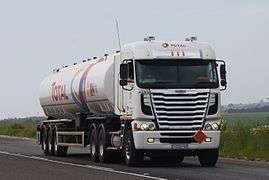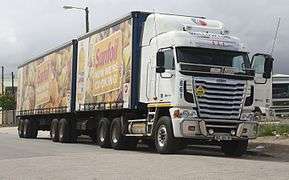Freightliner Argosy
| Freightliner Argosy | |
|---|---|
.jpg) | |
| Overview | |
| Type | Truck |
| Manufacturer | Freightliner Trucks (Daimler Trucks North America) |
| Production | 1998-present |
| Model years |
|
| Assembly | United States: Cleveland, North Carolina |
| Body and chassis | |
| Class | Class 8 truck |
| Body style |
COE
|
| Layout |
4x2 6x4 |
| Powertrain | |
| Engine |
Cummins 500/6 IL Cummins 620/6 IL Series 60 470/6 IL Series 60 500/6 IL Cummins 530/6 IL |
| Transmission |
18-speed Eaton-Fuller UltraShift - PLUS 18-Speed Eaton-Fuller Autoshift Eaton-Fuller 10 speed, 13 speed, and 15 speed. |
| Chronology | |
| Predecessor | Freightliner FLA/FLB/FLC/FLT |
| Successor | none (in North America) |
The Freightliner Argosy is a model line of cabover trucks produced by the American truck manufacturer Freightliner. Introduced in 1999 as the replacement for the FLB cabover, the Argosy is a Class 8 truck, currently in its second generation.
Following the 2006 model year, Freightliner withdrew the Argosy from its model line in the United States and Canada, making it the final Class 8 cabover semitractor sold in North America.
The Freightliner Argosy is produced by Freightliner in its facility in Cleveland, North Carolina; since 2007, production is exported nearly exclusively to South Africa, Australia, and New Zealand.
Model overview
The Freightliner Argosy initially was produced as a 1998 concept vehicle, derived from the Century Class conventional. In addition to sharing its doors, windshield, grille, and headlamps, the Argosy adopted telematics from the Century Class; with the truck having electronic braking, messaging capability, daytime running lights, and traction control.[1] The cabover configuration was chosen in an effort to promote the use of 58-foot trailers, allowing for the reduction of highway truck traffic.[1]
Entering production in 1999, the Argosy adopted virtually all the features of the 1998 concept vehicle.[2] While offered solely with the axle below the driver (in place of the usual set-forward or set-back front axle), several cab configurations were produced. Along with a 63-inch BBC daycab, cab lengths of 90 inches, 101 inches, and 110 inches were offered, with a mid-roof sleeper and a raised-roof sleeper (110 inches only).[2] While sharing a 2-piece windshield configuration with the Century Class as standard[1], a 1-piece windshield with 3 windshield wipers was an option.[2]
On all sleeper-cab variants, the Argosy was offered with electrically-powered pivoting entrance steps.[1][2] In contrast to many American cabover trucks, the engine intrusion inside the cab was largely eliminated, raising the floor only three inches between the seats, with the gear shifter integrated into the dashboard console.[2] As with conventional-cab trucks, drivers were able to walk into the sleeper cab.
In 2012, a second generation of the Argosy was introduced; this version has been sold exclusively for export, with all sales in the United and Canada consisting of glider truck kits.[3] With the latter, the customer purchases a completed truck body and frame, providing their own drivetrain (engine, transmission, driveshaft, and axles).[4] While retaining the basic cab structure designed in 1999, the second-generation Argosy shifted design influence from the Century Class to its replacement, the Freightliner Cascadia, adopting a similar dashboard design; in place of the two-piece grille derived from the Century Class, the Argosy received its own single-piece grille (loosely previewing the second-generation Cascadia).
.jpg) First-generation Freightliner Argosy (2011 pictured)
First-generation Freightliner Argosy (2011 pictured).jpg) Second generation Freightliner Argosy (2012 pictured)
Second generation Freightliner Argosy (2012 pictured)
Export use
As part of its development, the Argosy was intended to comply with European crashworthiness standards, becoming one of the safest trucks tested of the time.[1] As cabovers remained popular in markets outside North America, Freightliner continued to produce the Argosy for export markets, developing right-hand drive versions for South Africa, Australia, and New Zealand.[5]
Along with offering right-hand drive, export versions of the Argosy offer several configurations not offered in North America, including twin-steer front axles (largely used on Western Star severe-service trucks), grille/bumper guards, and axle layouts configured for road trains (not used in the United States and Canada).
.jpg) First-generation Argosy in South Africa
First-generation Argosy in South Africa.jpg) Argosy crew-cab in Chile
Argosy crew-cab in Chile.jpg) 2006 Argosy 8x4 twin-steer flatbed towing trailer in New Zealand
2006 Argosy 8x4 twin-steer flatbed towing trailer in New Zealand.jpg) 2007 Argosy 8x4 twin-steer in New Zealand transporting flatbed trailer
2007 Argosy 8x4 twin-steer in New Zealand transporting flatbed trailer Second-generation Argosy towing tanker in South Africa
Second-generation Argosy towing tanker in South Africa Second-generation Argosy towing tandem trailers in South Africa
Second-generation Argosy towing tandem trailers in South Africa
References
- 1 2 3 4 5 "Freightliner Trucks". 1999-04-28. Retrieved 2018-09-04.
- 1 2 3 4 5 "Wayback Machine" (PDF). 2005-10-31. Retrieved 2018-09-04.
- ↑ "https://web.archive.org/web/20121128215911/http://dtnaglider.com:80/Models.aspx". web.archive.org. Retrieved 2018-09-04. External link in
|title=(help) - ↑ "Glider Kits" (PDF). Freightliner.com. Archived from the original on 8 July 2018. Retrieved 2015-08-01.
- ↑ "1,100 jobs: Freightliner workers laid off in 2009 will be first hires". 2012-01-13. Archived from the original on 2012-02-18. Retrieved 2018-09-05.
External links
| Wikimedia Commons has media related to Freightliner Argosy. |